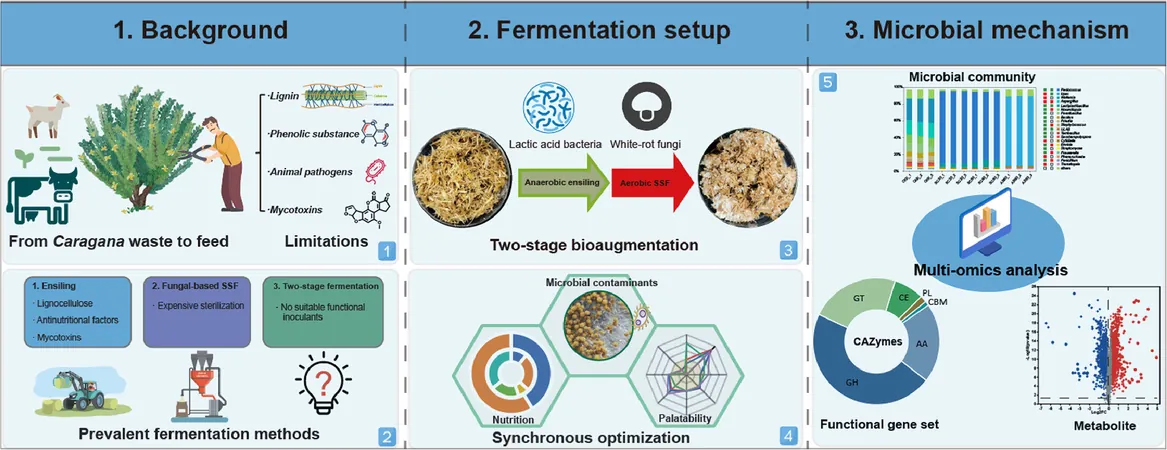
Revolutionary Method Transforms Caragana Waste into Game-Changing Ruminant Feed
2024-09-26
Author: Wei Ling
Introduction
In a groundbreaking advancement for agricultural waste management, researchers from the Chinese Academy of Sciences have developed a pioneering method to convert Caragana korshinskii Kom. waste—a prevalent forestry by-product in China—into a nutritious feed for ruminants. The findings, published in the esteemed Journal of Bioresources and Bioproducts, unveil a two-phase bioaugmentation process that enhances the nutritional properties and safety profile of this previously underutilized waste.
Challenges with Caragana Waste
Caragana waste is abundant, yet its high lignin content along with the presence of anti-nutritional factors (ANFs) like tannic acid and phytic acid have made it difficult to incorporate into animal feed. Conventional methods such as ensiling and fungal solid-state fermentation (SSF) have struggled to effectively tackle these challenges, leading to the need for innovative solutions.
The TBA Process
The newly developed technique, termed the TBA (Two-Stage Bioaugmentation) process, consists of an anaerobic ensiling phase followed by an aerobic SSF phase. During the initial phase, the Caragana waste is treated with Lactiplantibacillus plantarum LP1, a probiotic bacteria that not only stifles harmful pathogens but also enriches the material with beneficial probiotics. This is followed by the second phase, where the ensiled waste is inoculated with Irpex lacteus F17, a white-rot fungus renowned for its ability to improve nutrient profiles while effectively reducing undesirable phenolic compounds and mycotoxins.
Results and Implications
The results of this study are nothing short of promising: crude protein levels in the Caragana waste surged by an impressive 39.2%, while reductions in lignin, total phenolic compounds, and tannic acid reached 24.4%, 52.2%, and 51.4%, respectively. Additionally, levels of harmful mycotoxins like aflatoxin B1, zearalenone, and vomitoxin plummeted to negligible levels, validating the safety of this innovative feed solution.
Expert Insights
The research team, guided by experts Guilin Du and Beiru He, emphasizes that the TBA methodology effectively transforms palatable but previously impractical CKK waste into a nutrient-rich and safe mycelium-based feed product. This advancement not only creates value from a previously overlooked forestry resource but also supports sustainable economic practices and ecological preservation.
Conclusion
Experts believe this transformative approach could reshape livestock farming globally, presenting a nutritious, safe, and eco-friendly alternative feed option. As the agricultural sector increasingly grapples with waste management issues, this innovative solution holds the potential to revolutionize how agricultural by-products are converted into valuable resources, paving the way for more sustainable farming practices and better resource utilization worldwide.
Future Outlook
Could this be the future of animal feed? Stay tuned as science continues to advance, transforming waste into wealth!

 Brasil (PT)
Brasil (PT)
 Canada (EN)
Canada (EN)
 Chile (ES)
Chile (ES)
 Česko (CS)
Česko (CS)
 대한민국 (KO)
대한민국 (KO)
 España (ES)
España (ES)
 France (FR)
France (FR)
 Hong Kong (EN)
Hong Kong (EN)
 Italia (IT)
Italia (IT)
 日本 (JA)
日本 (JA)
 Magyarország (HU)
Magyarország (HU)
 Norge (NO)
Norge (NO)
 Polska (PL)
Polska (PL)
 Schweiz (DE)
Schweiz (DE)
 Singapore (EN)
Singapore (EN)
 Sverige (SV)
Sverige (SV)
 Suomi (FI)
Suomi (FI)
 Türkiye (TR)
Türkiye (TR)
 الإمارات العربية المتحدة (AR)
الإمارات العربية المتحدة (AR)